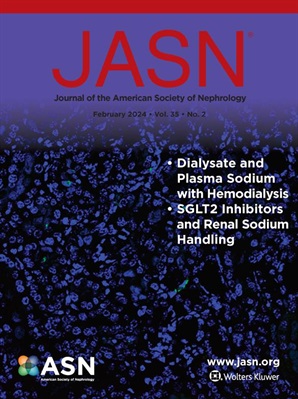通过胱氨酸/谷氨酸转运体合成谷胱甘肽促进肾脏三级淋巴结构的形成。
IF 9.4
1区 医学
Q1 UROLOGY & NEPHROLOGY
引用次数: 0
摘要
背景:三级淋巴样结构是慢性炎症诱导的异位淋巴样组织,在多种肾脏疾病中发展,并与不良预后相关。免疫系统需要代谢资源来支持免疫功能和淋巴细胞增殖。因此,剧烈的代谢变化可能发生在三级淋巴结构的形成过程中。然而,尚不清楚代谢重塑是否发生在这种形成过程中及其潜在机制。方法采用成像质谱法和代谢组学方法研究小鼠肾三级淋巴样结构的代谢途径。我们还利用免疫荧光和药物抑制进行原位杂交,以探索控制关键代谢途径的关键分子的表达和功能。我们分析了小鼠和人类的尿液样本,以探索估计肾三级淋巴结构存在的代谢物。结果在三级淋巴结构中观察到谷胱甘肽的积累和半胱氨酸的消耗,半胱氨酸是谷胱甘肽合成所必需的。具有三级淋巴样结构的肾脏的谷胱甘肽浓度高于健康肾脏。三级淋巴结构也显示出氧化应激标志物4-HNE和8-OHdG的显著积累。三级淋巴结构内的树突状细胞和成纤维细胞表达调节谷胱甘肽合成的胱氨酸/谷氨酸转运蛋白,并将合成的谷胱甘肽供应给缺乏表达的淋巴细胞。药物抑制胱氨酸/谷氨酸转运蛋白可阻止肾脏三级淋巴结构的形成。此外,三级淋巴结构内谷胱甘肽合成增强反映在小鼠和人尿中谷胱甘肽浓度升高,这有效地检测了IgA肾病患者肾脏中三级淋巴结构的存在。结论谷胱甘肽在肾脏三级淋巴组织内蓄积明显。抑制胱氨酸/谷氨酸转运蛋白可阻止三级淋巴结构的形成。尿谷胱甘肽可作为检测肾脏三级淋巴结构的生物标志物。本文章由计算机程序翻译,如有差异,请以英文原文为准。
Glutathione Synthesis via the Cystine/Glutamate Transporter Promotes the Formation of Tertiary Lymphoid Structures in the Kidney.
BACKGROUND
Tertiary lymphoid structure, an ectopic lymphoid tissue induced under chronic inflammation, develops in various kidney diseases and is associated with poor prognosis. The immune system requires metabolic resources to support immune function and lymphocyte proliferation. Hence, dramatic metabolic alterations presumably occur during the formation of tertiary lymphoid structure. However, it remains unclear whether metabolic remodeling occurs during this formation and its underlying mechanism.
METHODS
In a murine model of renal tertiary lymphoid structures, we used imaging mass spectrometry and metabolome analysis to investigate the metabolic pathway that characterizes tertiary lymphoid structures. We also performed in situ hybridization with immunofluorescence and pharmacological inhibition to explore the expression and function of the key molecules governing the pivotal metabolic pathway. We analyzed urine samples from mice and humans to explore the metabolites estimating the presence of renal tertiary lymphoid structures.
RESULTS
Significant glutathione accumulation and depletion of cysteine, which is essential for glutathione synthesis, was observed specifically within tertiary lymphoid structures. The kidneys with tertiary lymphoid structures exhibited higher glutathione concentrations than healthy kidneys. Tertiary lymphoid structures also showed significant accumulation of 4-HNE and 8-OHdG, markers of oxidative stress. Dendritic cells and fibroblasts within tertiary lymphoid structures expressed the cystine/glutamate transporter, that regulates glutathione synthesis, and supplied synthesized glutathione to lymphocytes, which lacked its expression. Pharmacological inhibition of the cystine/glutamate transporter prevented tertiary lymphoid structure formation in the kidney. Furthermore, enhanced glutathione synthesis within tertiary lymphoid structures was reflected in elevated urinary glutathione concentrations both in mice and humans, which effectively detected the presence of tertiary lymphoid structures in the kidney in IgA nephropathy patients.
CONCLUSIONS
Glutathione significantly accumulated within tertiary lymphoid structures in the kidney. Inhibition of the cystine/glutamate transporter prevented the formation of tertiary lymphoid structures. Urinary glutathione served as a biomarker to detect tertiary lymphoid structures in the kidney.
求助全文
通过发布文献求助,成功后即可免费获取论文全文。
去求助
来源期刊
CiteScore
22.40
自引率
2.90%
发文量
492
审稿时长
3-8 weeks
期刊介绍:
The Journal of the American Society of Nephrology (JASN) stands as the preeminent kidney journal globally, offering an exceptional synthesis of cutting-edge basic research, clinical epidemiology, meta-analysis, and relevant editorial content. Representing a comprehensive resource, JASN encompasses clinical research, editorials distilling key findings, perspectives, and timely reviews.
Editorials are skillfully crafted to elucidate the essential insights of the parent article, while JASN actively encourages the submission of Letters to the Editor discussing recently published articles. The reviews featured in JASN are consistently erudite and comprehensive, providing thorough coverage of respective fields. Since its inception in July 1990, JASN has been a monthly publication.
JASN publishes original research reports and editorial content across a spectrum of basic and clinical science relevant to the broad discipline of nephrology. Topics covered include renal cell biology, developmental biology of the kidney, genetics of kidney disease, cell and transport physiology, hemodynamics and vascular regulation, mechanisms of blood pressure regulation, renal immunology, kidney pathology, pathophysiology of kidney diseases, nephrolithiasis, clinical nephrology (including dialysis and transplantation), and hypertension. Furthermore, articles addressing healthcare policy and care delivery issues relevant to nephrology are warmly welcomed.

 求助内容:
求助内容: 应助结果提醒方式:
应助结果提醒方式:


